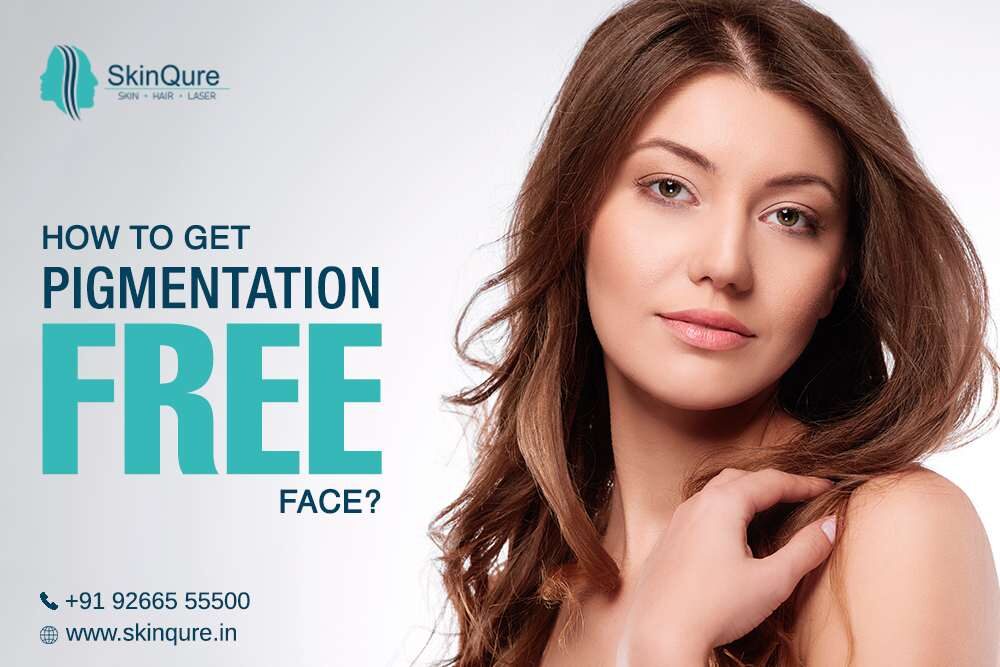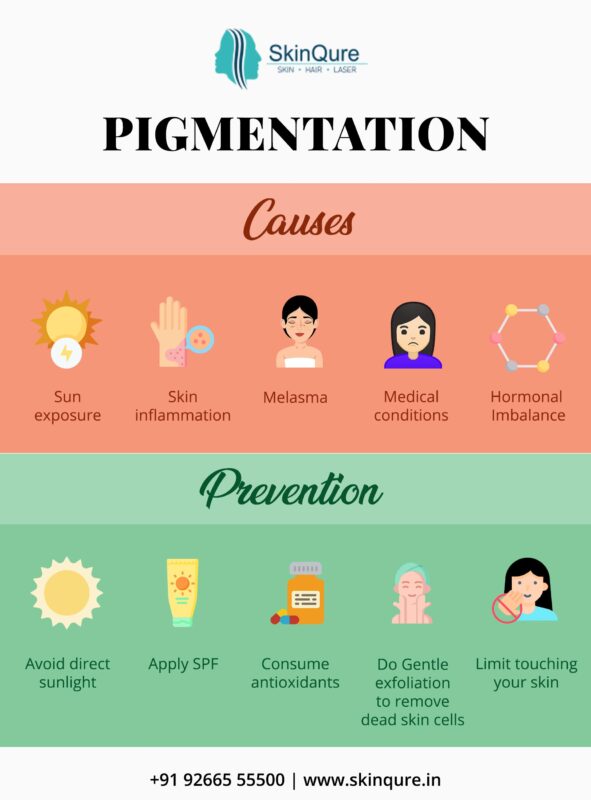
Are you worried and wondering about some dark brownish spots on your skin or darkened blotchy and patchy skin? This condition is called Pigmentation in which some skin patches become darker/lighter than the surrounding skin because of excess/inadequate melanin(Brown pigment which produces normal skin color) deposition on the skin.
But don’t worry, if you wish to say goodbye to this condition and want to have smooth and flawless skin, the pigmentation removal can be very effectively and easily done at Skinqure, the best skin/hair clinic in Delhi/NCR. Here in this article, we will give you an insight into what causes pigmentation, its treatment, and prevention.
Feel Free to Skip Ahead if One Topic Catches Your Eye:
- What Are The Causes of Pigmentation?
- How To Remove Pigmentation Permanently?
- Will Pigmentation Reoccur After You Stop The Treatment?
- FAQ’s
Takeaway
1. What Are The Causes of Pigmentation
Let’s look into how the pigmentation is caused:
- Excess Sun Exposure: Also called sun spots or liver spots which cause an increase in melanin due to UV rays and are seen mostly on hands and face.
- Hormonal changes: Also called Melasma and mask of pregnancy. Because of hormonal disturbances, there is an increase in melanin, resulting in pigmentation. It is mostly seen during pregnancy but can be seen otherwise too because of hormonal changes due to any reason. Occurs mostly on the hands and face.
- Few Chemotherapy drugs: As a result of direct toxicity due to chemotherapy drugs, stimulation of melanocytes occurs causing pigmentation.
- Some inflammatory diseases and other medical conditions– Inflammatory diseases like dermatitis, infection causes dark skin patches.
- Systemic lupus Erythematosus: rashes on the cheek and nose.
- Lichen Planus: irregular brown-grey patches on the skin) etc. Other diseases like
- Albinism: An inherited disorder caused by the absence of melanin resulting in discoloration of skin, hair, and eyes.
- Vitiligo: Immune system prevents melanocytes to produce melanin causing loss of skin color usually around the mouth, eyes, and hands.
- Addison’s disease: darkening of the skin in areas exposed to direct sunlight.
- Acanthosis Nigricans: pigmentation at the thigh areas.
- Chemical or Physical Injury: Burns due to some chemical substances like metals, antibiotics, cardiac medicines, dyes, etc. or a thermal burn or any physical injury like cuts or scratches, post-acne skin pigmentation or a skin tear can cause darkened patches on the skin.
- Deficiency of some vitamins: The deficiency of Vitamin B12 and Vitamin B9 sometimes causes patchy skin.
- Tobacco smoking: Increases melanin production and also constricts the blood vessels resulting in improper blood supply, leading to dark patches on the skin.
- Freckles: Same as sunspots but larger, mostly seen on lighter skin and fades away quicker than sunspots.
- Hori’s Nevus: Small grey-blue macules pigmentations are mostly on both sides of the forehead and are mostly in the inner layers of the skin.
2. How to Remove Pigmentation Permanently?
Nowadays we have lots of options for permanent pigmentation removal.
Chemical Peels: In this method, the outermost skin layer (epidermis) is removed and the inner skin cells are stimulated to grow, resulting in smoother, healthier, brighter skin. This can be mild, medium, or deep peel depending upon how deep the Skin layers are removed. The deeper the skin removal, the more dramatic are the results. Depending on which level is required, different chemicals are used. Examples are Alpha hydroxy acids like lactic, glycolic, or fruit acids. These may also cause side effects like redness, irritation, swelling, and blistering. You will have to protect yourself from direct sunlight. This may be used in age spots, sun damage, Melasma. Always discuss the need for your skin with the doctor.
Pigmentation laser: There are two types of laser therapy ablative which remove the top skin layer and heats inner layers and non-ablative which heat the underlying skin layers without harming the top layer. This medical ablative laser therapy gives a high-energy laser beam in short pulses which travels through the skin layers and breaks the melanin particles. This treatment does not cause thinning of your skin and causes mild discomfort. The results are seen after a while and multiple sessions may be required.
Intense Pulsed Light (IPL) to reduce pigmentation: This is a type of non-ablative laser treatment, also known as photofacial, which stimulates the growth of collagen within the inner skin layer (dermis). It uses a flashgun that emits broad-spectrum light which penetrates through the outer and the inner skin layer and breaks the melanin particles. The skin is prepared with the application of a cool gel and you will feel like rubber bands are put on your skin but it is not painful. One session takes around 20-30 minutes.
Lightening Creams: These are medical products containing ingredients that lower the level of melanin thus reducing pigmentation especially those which are not deep. You need to usually apply once or twice a day. They are best used for Melasma or age spots and are effective on most skin types. Sometimes it may cause skin irritation and cannot treat deep pigmentations. Always protect your skin from direct sunlight and have routine check-ups with the dermatologist.
Retinoids: They are small molecular structures that are derived from vitamin A and they can go deep in the skin and treat pigmentation by reducing melanin and increasing cell turnover. It is normally safe for all skin tones. Always consult your dermatologists before using them.
Microdermabrasion- An applicator with an abrasive surface is used which gently removes the outer skin layer so that it rejuvenates. Used for superficial pigmentation like age spots, Melasma, acne scarring, etc.
Dermabrasion: It is almost the same as microdermabrasion but it treats the inner dermis layer too.

3. Will Pigmentation Reoccur After You Stop The Treatment?
Skin pigmentation removal can be quite long-term or may be permanent or reoccur depending upon the cause and type of pigmentation, treatment, and skin. It tends to recur not because the treatment is stopped but due to constant exposure to sun or the pigmentation causing drug or chemical, therefore following doctor’s instructions, adopting measures to protect from the sun, and taking good care will help you attain sustainable results. Some of the tips to prevent recurrence and maintain better results are:
- Always keep your skin moist by applying moisturizer.
- Prevent scratching bug bites, blackheads, and other injuries.
- Always apply a broad-spectrum sunscreen with a good SPF (Sun Protection Factor) before going into the sun. Ask your dermatologist regarding SPF best for your skin type.
4. FAQ’s
- Birthmarks: Discolorations present right from birth or a few weeks after birth.
- Albinism
- Melasma
- Post-inflammatory hyperpigmentation (Due to skin damage)
- Vitiligo
Application of these materials on your affected skin will lighten, brighten and have a depigmentation effect on your skin. Immediately discontinue and seek a dermatologist’s advice if redness, itching, etc. occurs.
- Apple cider vinegar
- Aloe Vera
- Red Onion
- Green tea extract
- Black tea water
- Licorice extract
- Milk
- Tomato paste
- Orchid extracts
- Masoor dal face masks
The best foods for clear and vibrant skin are juicy and citrus fruits and green and leafy vegetables like kale, spinach, sweet potatoes, lemons, broccoli, berries, pumpkin, carrots, seeds and nuts, fatty fish and legumes, lots of water. These are rich in antioxidants and beta carotene (Orange colored) which reduce skin darkening by reducing free radicals, enhance melanin production, and support skin turnover. Avoid Sugary and fried foods, alcohol, white bread, white rice, excess salts, spicy foods, and caffeine products. Seafood rich in copper, manganese, selenium, and zinc is beneficial.
Pigmentation means a change of normal skin color due to any reason. It may be hyperpigmentation means darkening of normal skin color or hypopigmentation which means lightening or discoloration of normal skin.
